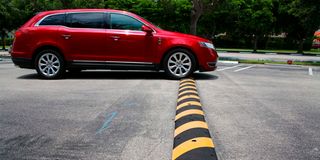Premium
Motor Clinic: No need to use the hooter every day

You should only use the horn in an emergency, to avert an imminent accident.
Gavin, what are the rules or good driving practices about sounding your car’s horn? Michael.
There is one main guideline which is supposed to be general knowledge – you should only use the horn in an emergency, to avert an imminent accident.
The horn should be used so rarely that it stands out amid other traffic noise, and immediately grabs the attention of anyone and everyone nearby. It is meant to be an alarm, meaning “help!” or “duck!” or “look out!” It should only be used, instantly and instinctively, when there is about to be a crash or other calamity, and immediate preventive action is required.
It should not be used for anything else, and it shouldn’t be used so frequently that it loses its ability to shock and alert and instead becomes a disturbance that others start to ignore.
Outside the context of motoring, it can be used to get the attention of others to come to the rescue, or run away from a menacing threat. For example, if the car is the nearest source of a very loud noise, you can sound the horn when a child has fallen in a river, when someone has had a heart attack, or a house is on fire.
There are grey areas where the use of a horn might be justified, like when the car ahead has had its right indicator flashing for several minutes and you want to overtake it. If a few flashes of your lights hasn’t woken up the driver, a beep to say “I’m coming” might be warranted. As might a beep if someone has parked across your driveway gate and failed to notice your arrival, though, strictly speaking, this is not an emergency and the issue can be resolved without hooting.
Nervous drivers who beep at everything probably should not drive at all. They are displaying a dangerous level of incompetence, and assuming that every other road user is equally inept. One driver in a car sharing pool in our area became infamous because on the 10km journey from neighbourhood to town, she routinely used the horn more than a dozen times! This, and her driving, was so distressing to the group that the rota was eventually changed so she was always in the back seat.
Of course, horns are used (misused) more frequently than they should be, with meanings ranging from a peep-peep “hello” and “goodbye” to the long blast representing an annoyed swearword, or “wake up, the light has turned green” or “open the gate” or “get out of my way”, or as a collective cacophony in celebration of a wedding or a cup final victory parade.
Those are technically an offence but, happily, not too serious a problem. They are reasonably rare and usually very brief, and, in the case of a celebratory cavalcade or an election campaign, they keep moving (as far away as possible, please).
This is not the same as compulsive hooting by anybody at everybody else in traffic, or the thankfully ended “customer-calling” habits of matatus, nor the hugely amplified and often hours-long harangue – in one static place - inflicted on every ear for miles around by evangelists or political orators. Worship is a private choice, and the freedom to do it should also enshrine the freedom not to have to listen to it. My ears are mine and, with respect, may I remind these perpetrators, that God is not deaf.
Apart from any letters of the law (NEMA has banned loudspeakers in most places, including churches, I believe) conduct should be guided by the single most universal multi-denominational or non-denominational moral question: “If everybody did what I am now doing, what would the world be like? Would the social system still work?”
Kenya is quite good at hooting traffic, very bad in the use of PA systems. Unwarranted noise has become a serious pollutant, second only to greenhouse gasses. Keep using your car when you must, but don’t use the hooter. Ration yourself to once or twice per year!

A Fuel attendant holding a fuel pump at the filling station along Kimathi Street.
How much has the rate of fuel consumption changed of late?
About half a century ago, most cars could go between 20 and 40 miles on a gallon of fuel. Any that did less than 20 miles on a gallon were gas guzzlers. Any that did better than 40 miles on a gallon was super economical. What would be the benchmarks today? Walter.
About the same. But the gas guzzlers would be those that did less than 8kms per litre, and the economical would be doing better than 15kpl. The big difference between then and now is the significantly higher proportion of cars in the super economy bracket (where the roads aren’t too bad and the traffic isn’t clogged).
As a quick reference, one kilometre per litre (kpl) is the same as 2.825 miles per gallon (mpg).
Either multiply or divide by that number (or a rounded three) depending on which direction you want to go. In parallel, most of us these days think of fuel consumption in terms of kilometres per litre, while some parts of the world - and many manufacturers - quote fuel efficiency as “litres per 100 kilometres”. Bonkers!
Presumably it is a marketing thing. In kpl, the more economical a car is, the higher its consumption number is (in kilometres). In litres per 100kms the more economical a car is the lower its consumption number is (in litres). Go figure.
The formula you need to translate that muddle is: To go from kms per 100 litres to kpl, divide 100 by the litres consumed figure. To go from kpl to litres per 100km, divide 100 by the kpl figure.
More cause for a Crie de Coeur than the Croix de Guerre. No apologies for the foreign language. Remember, the Britons spoke a lot of French before many of the people in France did. Which, by the way, puts the over-zealous notion of “culture theft” in perspective.

A car stops at a speed bump.
There’s need to rethink the national strategy on bumps
Dear Mr Gavin, I enjoy your articles and find them informative.
I agree with you on the effectiveness of bumps on the southern bypass approaching Dagoretti from Kikuyu. However, KENHA (or whichever body erects bumps on this highway) recently introduced very sharp rumble strips - I think these are illegal given your article and are even a threat to drivers who now have to slow down on a hill with heavy trucks speeding downhill behind them. How can we petition KENHA to remove these rumble strips and leave the road as it was - or maybe add more user-friendly humps?
Regards, Wanjiku
Also, among many…
I emphatically agree with your recent comments on speed bumps, and I would add the increasing number of rumble strips which make my car dance sideways if I cross them at any speed other than dead slow. Surely these strips should have an even stricter standard. Do they? Jeremiah.
On paper, yes. On our tarmac, no. Rumble strips should be so nearly flat (less than one centimetre?) that they have no effect on the handling of a car…at any speed! Indeed, they are widely used in the rest of the world on the biggest, fastest highways when cars are supposed to be travelling at or near the limit, which in the USA would be 90kph, Kenya 100kph, Canada 110kph, UK
112kph, France 130 kph, and in Germany sometimes unlimited.
Their role is to warn – well before a hazard – that the previous stretch of very high speed conveyor-belt motoring will soon be interrupted. They give possibly over-relaxed drivers a little wake-up call by causing a gentle but unmistakable thrum – just enough to be sensed by the ears, the fingertips and the seat of the pants. That’s why they are called “rumble” strips, not *hokey-kokey pogo-stick strips .
Correctly designed (a dozen strips no thicker than the floor mats in your car spaced over a few metres) they are helpful, completely harmless and cause zero difficulty, discomfort or indignation. Their message (after crossing them) is “now start to ease off and stay alert, you will soon have to reduce speed.” They are the best possible “signpost” of approaching hazards (including speed bumps). They don’t get rubbed out or knocked over or stolen, and you know they are there (feel them) even in thick fog. The point of emphasis here is that they are not designed or intended to be crossed slowly. They are designed to be crossed at the full ambient speed of the traffic flow.
Some are built like that, and they are a blessing – to warn of an oncoming junction or a mega-bump… that is often not signposted or marked, often nearly invisible, and often severe enough to cause damage or a catastrophic accident if taken (unseen) at full speed.
There are also more than a few of our rumble strips that are not built correctly. Some - as singles or multiples – are the shape and girth of recumbent fenceposts. Others are less severe than that but still much thicker than they should be. Cars with sound suspensions can negotiate most of them at full speed with a bit more than a “thrum” but no damage or loss of control. But cars with sub-standard suspensions slow down to walking pace to avoid alarming axle-tramp – often causing following traffic (which is expecting cars ahead to maintain speed at that point) to take urgent evasive action!
I have watched cars (and especially light trucks) crossing rumble strips at reasonable speed, and seen their rear wheels bounce several centimetres off the ground...with a sideways kick. Some such strips – and even full-scale bumps – are positioned on a bend at the bottom of a steep sided valley just before a bridge! Not the best place to lose control. These bumps don’t warn of a danger which is usually self-evident. They are the danger. The whole national strategy on bumps is in dire need of a re-think and overhaul.
(* The hokey-kokey is a “shake-it-all-about” folk dance also known as
the “Hinkumbooby Roundabout” or the “Hilli ballu ballai” or the “Looby Looby” – onomatapoeically ironic, wouldn’t you say, in the context of “traffic calming”?)





